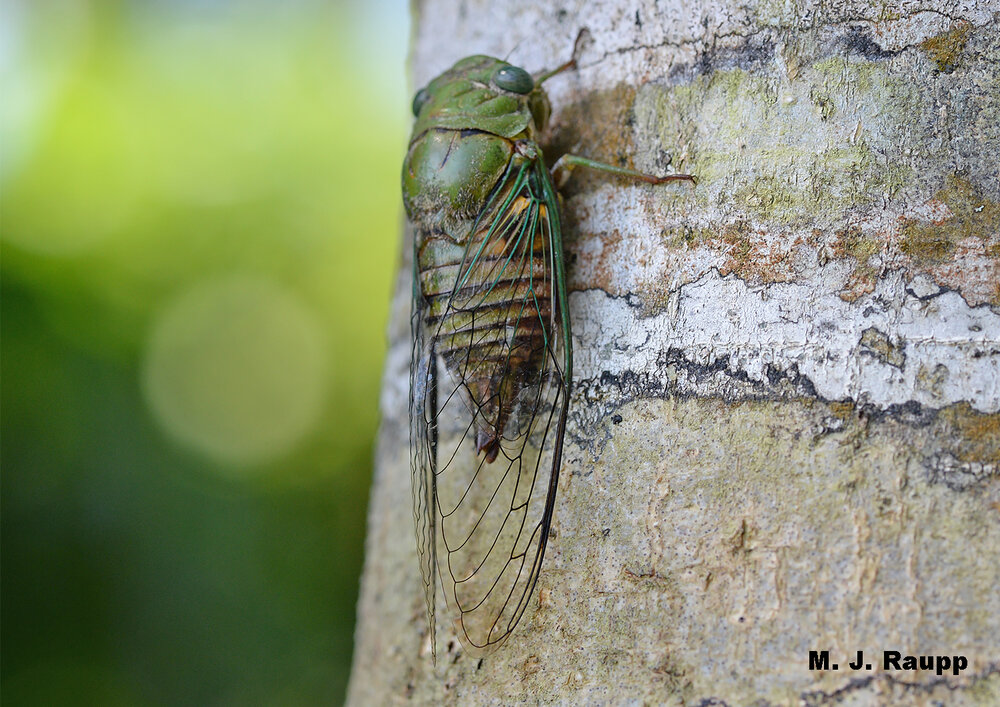Rain on a sunny day: Tropical rainforest cicadas, Dorisiana sp.

Massive appearances of rainforest cicadas like Dorisiana cachla can make it rain on a sunny day in a tropical rainforest.
Over the years, we have visited magical periodical cicadas of Brood II, Brood V, Brood X, Brood XIII, and Brood XIX as they appeared in the eastern half of North America. This week we venture once again some 2,000 miles south to the rainforests of Costa Rica where we previously visited agrarian leaf cutter ants, rapacious army ants, and mutualistic ants protecting Acacia and Cecropia trees. Unlike periodical cicadas that emerge by the millions in prime number years of 13 and 17, several species of cicadas in Costa Rica make their appearances annually. The diversity of Costa Rican cicadas of about 30 species rivals that of eastern North America.
The immature stages of cicadas, called nymphs, spend the majority of their life underground sucking sap from the vascular xylem tissue of roots. Xylem transports water and minerals from the soil to the photosynthetic tissues in the canopy of the plant; however, compared to other plant tissues, xylem is rather low in nutrient content. Bear with me, this is important later. After completing development in their subterranean crypts, a process lasting one to several years depending on the species, nymphs emerge from circular holes in the soil, usually at twilight, and race to vertical structures to climb up and shed their skins. At night tree trunks and other vegetation are festooned with nymphs as they escape their nymphal exoskeletons and emerge as adults. After molting they scramble to the relative safety of the canopy. Once the new exoskeleton hardens, they fly to the treetops to join others of their species in a spectacular throng of cicadas chorusing, courting, mating, and feeding. No social distancing here!
At twilight cicada nymphs emerge from circular escape holes in the soil to scale vegetation and shed their exoskeleton. Next stop will be the treetop to join the chorus and find a mate.
On a recent visit to the rainforest with a group of curious naturalists, we visited a rambunctious swarm of cicadas cavorting in the treetops. Bug of the Week viewers who have witnessed the emergence of periodical cicadas here in the United States will recall the other-worldly sound and volume of a cicada chorus. Their songs can approximate 100 decibels, a noise as loud as a four-cycle lawn mower engine. As we approached a forested ridge near the heart of a cicada chorus, the volume seemed to best that of our periodical cicadas back home. Some of our brave adventurers described the sound of the chorus as “painful”. Witnessing the big boy band in the treetops (only the males sing) was fascinating, but what really sparked my interest was a promise made by our guide who claimed cicadas would be so numerous in the treetops that their “pee” would be like rain. Well, thinking back to John Fogerty’s 1970 lyrical query “I wanna know, have you ever seen the rain, comin’ down on a sunny day”, how could one not resist the chance to experience a cicada shower? Recall that cicada nymphs feed on nutrient poor xylem of plant roots. Cicada adults have sucking mouthparts and they too imbibe xylem fluid, lots of it. Due to the low concentration of nutrients in xylem, cicadas must process vast quantities of sap to gain sufficient nutrients. Their specialized digestive tract enables them to suck copious amounts of sap from the tree and rapidly excrete the excess fluid. Not exactly “pee”, but surely liquid waste. And sure enough, our guide spoke truly. Amidst the cicada chorus in a rainforest on a ridgetop, I did indeed see and feel rain comin’ down on a sunny day.
High on a ridgetop in a tropical rainforest, cicadas gather to chorus, court, and mate. To sustain these activities, they imbibe large quantities of xylem fluid. Amidst the thunderous din of their serenade, copious excess fluid is excreted and creates a cicada shower. In the cicada-filled rainforest it does indeed rain on a sunny day.
Acknowledgements
We thank Costa Rica Vacations, wildlife enthusiasts Jerri, Parker, Richard, Anita, Maya, and the intrepid guides Mono and Kenneth at Rafiki Lodge and Ale and Gera at Playa Cativo Lodge, for providing the inspiration for this episode. Huge thanks to cicada sleuth Ale for putting the likely name of Dorisiana cachla on this week’s star. The informative article “Cicada Ecology in a Costa Rican Tropical Rain Forest” by Allen M. Young, and the Cicada Mania Website were used as references for this episode.
This post appeared first on Bug of the Week